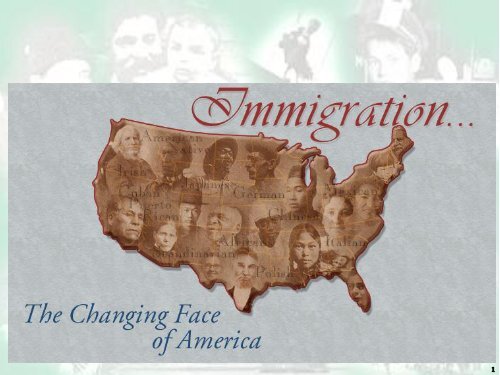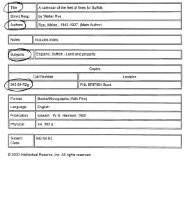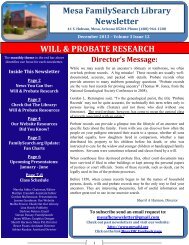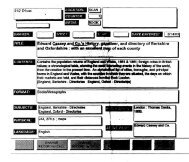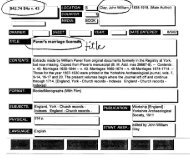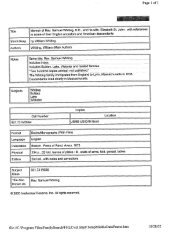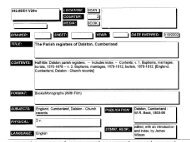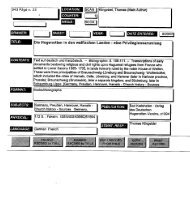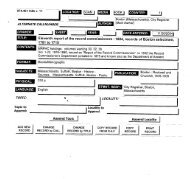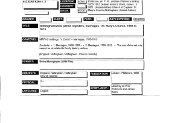IMMIGRATION RECORDS - Mesa FamilySearch Library
IMMIGRATION RECORDS - Mesa FamilySearch Library
IMMIGRATION RECORDS - Mesa FamilySearch Library
You also want an ePaper? Increase the reach of your titles
YUMPU automatically turns print PDFs into web optimized ePapers that Google loves.
Schematic<br />
diagram<br />
of a<br />
country<br />
and its<br />
population<br />
centers<br />
Emigration & Immigration<br />
Emigration (Exit)<br />
Immigration (Come In) 2
Who, What, Where and<br />
Why Did They Leave?<br />
3
Waves of Immigrants<br />
•Ther e ar e mor e than one hundr ed differ ent ethnic<br />
backgr ounds among America‟s population today.<br />
•Not every gr oup came to America at the same time.<br />
•Ther e ar e some general historical tr ends that may affect the<br />
dir ection of your r esear ch.<br />
4
Historical Immigration Trends<br />
•1500's - 1776: Colonial Period - English, African, Spanish,<br />
French, Dutch, German, Welsh, Finnish, Scottish, and Scotch-<br />
Irish.<br />
•1776 - 1820: Continuation of same groups but in decreasing<br />
numbers due to international wars and early attempts at<br />
immigration restriction.<br />
•1820 - 1880: Catholic Irish, German, Norwegian, Swedish,<br />
Danish, Chinese, Japanese, French Canadian.<br />
5
•1880 - 1920: Italian, Polish, Austrian, Czech, Slovak,<br />
Yugoslav, Romanian, Russian, Hungarian, Greek, Arabs,<br />
Jews and Japanese.<br />
•1920 - 1945: German, Italian, Polish, Czech, British, Irish,<br />
Canadian and Mexico - also refugees from Nazi Germany.<br />
•1945 - today: Canadian, Mexican, Central & South<br />
American, Caribbean, Korean, Vietnamese, Laotian,<br />
Cambodian, Middle Easter Arab, Soviet Jewish<br />
6
Why did they come?<br />
Push Factors: Conditions in the homeland are<br />
pushing them to leave<br />
· Religious persecution<br />
· Economic hardship<br />
· War, mandatory military conscription<br />
· Had no choice - for ced to leave; slaves, convicts,<br />
r eligious non-conformists, etc<br />
7
Pull Factors: Conditions in the<br />
new country ar e pulling them to a better<br />
life<br />
· Availability of land<br />
· Jobs<br />
· Religious fr eedom<br />
· Family who had alr eady<br />
immigrated encouraged others to join<br />
them in America<br />
8
They came on ships<br />
•In 1620, it took the Mayflower sixty-six days to cross the<br />
Atlantic.<br />
•By the 1840‟s, the average length for sailing ships fr om the<br />
British Isles was five to six weeks. W ith those fr om the<br />
Eur opean continent taking a week or so longer.<br />
•After the Civil War, the majority of immigrants arrived on<br />
steamships. Voyage time fell initially to about two weeks and it<br />
continued to decline into the twentieth century.<br />
•Steamships r emained the primary means of travel until after<br />
World War II.<br />
•Most immigrants now arrive by airplane.<br />
9
What were conditions like?<br />
•Over crow ding<br />
•Seasickness<br />
•Disease ridden<br />
•Inadequate pr ovisions<br />
•Unsafe drinking w ater<br />
•Bad w eather<br />
•Poor navigation<br />
•In 1818, out of 5,000 passengers w ho sailed from Antw erp to America, about 1,000 died.<br />
• Fr om one Eur opean port mor e than 700 of 1,267 passengers aboard one ship died from<br />
“Ship Fever”<br />
• 500 passengers died in a fire on the Austria in 1858.<br />
•In 1847, 17,000 immigrants died of typhus aboard ship or in quarantine shortly after<br />
arriving in America.<br />
•43 ships failed to reach their North American destination betw een 1847 and 1852.<br />
10
First Class and Second Class<br />
•Private accommodations<br />
•Upper-most decks<br />
•Nice dining halls<br />
•Attendants for passenger assistance<br />
•Upon arriving in America – passengers were inspected onboard ship.<br />
Steerage / Third Class<br />
•Dorm-like accommodations<br />
•Little, if any, privacy<br />
•Lowest decks<br />
•Limited restroom facilities<br />
•Often expected to furnish own food<br />
•Usually debarked ship for processing in America<br />
•Ellis Island processed only steerage passengers<br />
11
The exits: Where Europeans boarded the ships to America<br />
12
Immigration<br />
The exits: Where Europeans boarded the ships to America<br />
13
Port History<br />
•New York: New York was not always the leading<br />
port, even though it was established by the Dutch<br />
in 1625. It was not until the Erie Canal opened<br />
in 1825 that New York became the busiest port of<br />
entry. Over 80% of immigrants arrived in<br />
America through Castle Garden then Ellis<br />
Island.<br />
•Boston: Founded in 1630, Boston was the<br />
leading trading and passenger port from the<br />
colonial period until 1750.<br />
14
•Baltimore: Baltimore, founded in 1729, is<br />
the best protected deep water port and closest<br />
East Coast port to the Midwest. Inspectors<br />
boarded ships at the mouth of the<br />
Chesapeake and completed inspections on<br />
board as the ship sailed north to Baltimore.<br />
•Philadelphia: Founded in 1682, Philadelphia<br />
rivaled Boston and for a short time was a<br />
leading port of immigration until New York<br />
rose to prominence. During the Irish potato<br />
famine, Philadelphia failed to establish<br />
adequate shipping lines to receive the influx<br />
of immigrants and fell behind the other major<br />
ports.<br />
15
•New Orleans: Founded by the French in<br />
1718 and controlled by Spain from 1762 until<br />
sold to the United States in 1803 as part of<br />
the Louisiana Purchase. Once it became a US<br />
port New Orleans grew to the fourth largest<br />
city in the United States by 1840. Travel up<br />
the Mississippi River made New Orleans the<br />
best way to access America's western<br />
interior. The Civil War brought an abrupt<br />
end to New Orleans heyday and it never<br />
regained its postion among the major ports.<br />
Besides US ports, many immigrants arrived at<br />
Canadian ports, especially Quebec City and<br />
Halifax – then just crossed the border into the<br />
United States<br />
16
US Customs & Passengers<br />
Lists began in 1820<br />
Before 1820<br />
• American colonies made no effort to require lists of<br />
immigrants<br />
•Before Revolutionary War there was no federal<br />
government to request these lists<br />
•Most immigrants were considered cargo – not passengers<br />
•Travelers recorded fellow passengers in diaries, journals<br />
and letters home<br />
•Cargo manifests & lists have been found in archives,<br />
museums, personal papers, bars & attics<br />
17
What is Filby‟s Passenger<br />
and Immigration Lists Index?<br />
Updated annually, the "Passenger and Immigration Lists Index,<br />
1500s-1900s" was compiled by P. William Filby and published by Gale<br />
Research. Many refer to this important work simply as „Filbys‟<br />
Prior to 1820, most ships coming to America did not keep<br />
documentation of who was on board. Many individuals traveled to their<br />
destination on uncomfortable, rat -infested cargo ships -- usually only five, ten,<br />
maybe thirty passengers suffered through the trip together. Because of this,<br />
finding documentation of your ancestors' journey to pre -1820 America can be<br />
almost impossible.<br />
That's why Filby‟s Passenger and Immigration List Index proves such an<br />
invaluable resource. Thousands of different records have been used to compile<br />
this index, everything from original passenger lists to personal diaries.<br />
18
After 1820<br />
•Federal Government began to regulate immigration<br />
•Official lists of passengers were required<br />
•Some cities, states, port officials and shipping lines also<br />
kept records<br />
•Passengers lists before 1880 rarely give immigrant‟s town<br />
of origin<br />
•Children who immigrated with parents were often not<br />
included on earliest lists<br />
•No official lists were kept until the late 1800‟s for border<br />
crossings from Canada & Mexico<br />
19
82% of Immigrants came<br />
through New York<br />
•Did your immigrant really arrive through Ellis Island?<br />
•Many people have come to believe that arriving through New<br />
York meant arriving through Ellis Island…not true.<br />
•Before August 1855 - wharfs of Manhattan<br />
•Castle Garden: August 1, 1855 - April 18, 1890<br />
•Barge Office: April 19, 1890 - Dec. 31, 1891<br />
•Ellis Island: January 1, 1892 - June 13, 1897<br />
•Barge Office: June 14, 1897 - Dec 16, 1900 (Ellis Island office<br />
burned and had to be rebuilt)<br />
•Ellis Island: December 17, 1900 -1924<br />
20
Ellis Island 1892-1924<br />
1905<br />
photo<br />
21
The Great Hall of Ellis, sometimes called the “Hall of Tears”<br />
•Doctors looked for signs of sickness or infirmity<br />
•Families could be separated as inspectors accepted some and rejected others<br />
•Important to create impression one could make a living in America<br />
•98% passed all inspections – 2% w ere rejected and deported<br />
•5,000 new immigrants a day w ere processed during peak years<br />
22
Finding them on a Passenger List<br />
To search for an ancestor on a passenger list<br />
•Determine full name<br />
•Approximate date of arrival<br />
•Approximate age<br />
•Likely port of arrival<br />
If the year of arrival is unknown and they were still living in<br />
early 1900‟s, try searching the 1900, 1910, 1920 and/or 1930<br />
census – as they each have a „Citizenship‟ column and ask the<br />
year of immigration to the US.<br />
23
If they were not alive in 1900, try<br />
to find the immigration year in:<br />
•Family records<br />
•Vital records<br />
•On tombstone<br />
•Court records<br />
•Military records<br />
•Passports<br />
•Voting registers<br />
•Ethnic church records<br />
•County histories<br />
•State census<br />
Land records – government land entry files<br />
28
NATURALIZATION<br />
THE LEGAL PROCESS THAT GIVES AN<br />
IMMIGRANT THE RIGHTS OF CITIZENSHIP<br />
29
NATURALIZATION BRINGS<br />
GREAT ADVANTAGES<br />
The privilege of voting – includes the opportunity<br />
to run for government office (except President and Vice<br />
President), women received the right to vote in 1920 with<br />
the 19 th amendment to the Constitution.<br />
The right to own property – was very important<br />
as the land was being settled. The Homestead Act of 1862<br />
provided a special incentive for foreigners to become<br />
citizens because it specified that only U.S. citizens, or<br />
immigrants who had filed a declaration of intention to<br />
become citizens, could own land.<br />
30
Civil rights – The new citizens had freedom of<br />
speech, religion and freedom of assembly.<br />
Protection of the law<br />
New responsibilities – New<br />
citizens are required to serve on<br />
juries, pay taxes and obey the laws<br />
of the country.<br />
31
NATURALIZATION <strong>RECORDS</strong> MAY<br />
PROVIDE IMPORTANT INFORMATION<br />
SUCH AS:<br />
IMMIGRANT‟S NATION OF ORIGIN<br />
BIRTH DATE<br />
DATE AND PORT OF ARRIVAL<br />
PLACE OF RESIDENCE<br />
NAMES & AGES OF FAMILY<br />
OCCUPATION<br />
FOREIGN AND<br />
AMERICAN NAMES<br />
32
Some immigrants changed their names to be “more American”.<br />
Some names were changed inadvertently when errors were<br />
made by those recording the information.<br />
33
REQUIREMENTS FOR<br />
NATURALIZATION HAVE CHANGED<br />
THE BASIC REQUIREMENTS ARE:<br />
RESIDENCY IN THE COUNTRY FOR<br />
FIVE YEARS<br />
GOOD MORAL CHARACTER<br />
AN OATH OF LOYALTY OR<br />
ALLEGIANCE<br />
KNOWLEDGE OF GOVERNMENT,<br />
HISTORY AND LANGUAGE<br />
34
HISTORICAL CHANGES<br />
The basic law was amended 20 times between 1790<br />
&1906 and another 20 times between 1906 & 1940.<br />
•Pre-1790 British immigrants were automatically citizens of the<br />
colonies. Some of the colonies had their own naturalization laws.<br />
After the Revolutionary War, the individual states established their<br />
own naturalization laws.<br />
•1790 The first Federal law for naturalization required 2 years in<br />
the U.S. and 1 year in the state where naturalized. No declaration of<br />
intention was required.<br />
35
•1795 The law required a declaration of intention, residency<br />
of 5 years (1 year in the state where naturalized), good moral<br />
character, and oath of allegiance. It became the cornerstone<br />
for future naturalization laws.<br />
•1798 the most stringent law was created. It required 14<br />
years of residency but that law didn‟t last long.<br />
•1802 the government returned to the 1795 requirements.<br />
•1906 the Bureau of Immigration and Naturalization was<br />
created. Federal agency controls all procedures. An Alien<br />
Registry was required.<br />
•1952 The Declaration of Intention became voluntary.<br />
36
•2001 The Child Citizenship Act: became effective on<br />
February 27. It amended the Immigration and Nationality<br />
Act (INA) to provide automatic U.S. citizenship to certain<br />
foreign-born children-including adopted children-of U.S.<br />
citizens:<br />
At least one parent or legal guardian had to be a U.S.<br />
citizen.<br />
•Orphans with a full and final adoption abroad or<br />
adoption finalized in the U.S.,<br />
•Biological or legitimated children,<br />
•Certain children born out of wedlock to a mother who<br />
naturalizes<br />
•Adopted children meeting a two-year custody<br />
requirement<br />
37
75,000<br />
BECAME<br />
CITIZENS<br />
The law also provided automatic citizenship<br />
to children born to U.S. citizens while abroad<br />
and out of the U.S.<br />
38
GROUPS GRANTED CITIZENSHIP BY<br />
LEGISLATION OR TREATY<br />
1803 LOUISIANA PURCHASE<br />
1819 FLORIDA<br />
Included Mississippi & Alabama<br />
1845 TEX AS<br />
1867 ALASKA<br />
1870 AFRICAN AMERICANS, 14 th AMENDMENT RIGHT TO<br />
VOTE<br />
1900 HAWAII/1917 PUERTO RICO /1927 VIRGIN ISLANDS<br />
1924 NATIVE AMERICANS<br />
COLLECTIVE<br />
NATURALIZATIONS<br />
2001 CHILD CITIZENSHIP ACT - no papers will be found<br />
39
BASED UPON CITIZENSHIP OF ANOTHER OR SERVICE<br />
PERFORMED:<br />
WOMEN<br />
DERIVATIVE<br />
CITIZENSHIP<br />
FROM 1790 TO 1922 A WOMAN TOOK THE<br />
CITIZENSHIP OF HER HUSBAND – DISCONTINUED IN<br />
1922<br />
AN ALIEN WOMAN WHO MARRIED A U.S. CITIZEN<br />
AUTOMATICALLY BECAME A CITIZEN.<br />
AN AMERICAN WOMAN LOST HER CITIZENSHIP IF<br />
SHE MARRIED AN ALIEN EVEN IF SHE NEVER LEFT<br />
THE U.S. SHE THEN HAD TO BE NATURALIZED TO<br />
BECOME A CITIZEN AGAIN.<br />
40
CHILDREN<br />
1790 – 1940 CHILDREN UNDER 21 AUTOMATICALLY<br />
BECAME CITIZENS WITH THEIR FATHERS<br />
1824 – 1906 MINOR ALIENS LIVING IN THE U.S. FIVE<br />
YEARS BEFORE THEIR 23 rd BIRTHDAY COULD FILE<br />
DECLARATIONS AND PETITIONS AT THE SAME TIME<br />
ALIENS OVER 21 WHO<br />
PERFORMED MILITARY SERVICE<br />
41
ALIENS SERVING<br />
IN MILITARY<br />
TAKING OATH<br />
CAMP UPTON,<br />
NEW YORK 1918<br />
Act of 9 May, 1918:<br />
Provided for immediate naturalization of soldiers<br />
No Declaration of intention needed<br />
No proof of residence needed<br />
No certificate of arrival needed<br />
Naturalized at camps and nearby courts<br />
May 1918 – June 1919, 192,000 naturalized<br />
42
NATURALIZATION<br />
PROCESS<br />
1. DECLARATION OF INTENTION - CALLED<br />
THE “FIRST PAPERS” BECAUSE FROM 1795 UNTIL 1952,<br />
COMPLETING THIS FORM WAS THE FIRST STEP TO<br />
BECOMING A CITIZEN. NOW THE DECLARATION IS<br />
ENTIRELY VOLUNTARY.<br />
2. 2 nd PAPERS - PETITION FOR<br />
NATURALIZATION<br />
3. OATH OF ALLEGIANCE<br />
4. CERTIFICATE OF NATURALIZATION<br />
43
LOCATING <strong>RECORDS</strong><br />
When searching for Naturalization records<br />
remember:<br />
Immigrants have never been required to<br />
apply for citizenship<br />
Some immigrants chose not to apply<br />
Not all who started the process<br />
completed the process<br />
44
DEVELOP A TIME & PLACE<br />
SEQUENCE FOR THE IMMIGRANT<br />
ANCESTOR<br />
Immigrants may have filed papers in<br />
several locations<br />
They may have started the process as soon as they got off<br />
the boat<br />
They may have waited until they settled<br />
They may have waited until late in their life<br />
45
Many other Places to Look<br />
•STATE CENSUSES<br />
•OLD CITY DIRECTORIES<br />
•LIBRARIES & ARCHIVES<br />
•VITAL <strong>RECORDS</strong><br />
•CEMETERY <strong>RECORDS</strong><br />
•LAND <strong>RECORDS</strong><br />
•RELIGIOUS <strong>RECORDS</strong><br />
•MILITARY <strong>RECORDS</strong><br />
•SOCIAL SECURITY <strong>RECORDS</strong><br />
•SHIP PASSENGER LISTS<br />
•NEWSPAPERS<br />
•LOCAL HISTORIES<br />
•ETHNIC HISTORIES<br />
•OBITUARIES<br />
•OCCUPATIONAL <strong>RECORDS</strong><br />
•INTERNET<br />
46
OTHER EVIDENCE OF<br />
COMPLETED<br />
REQUIREMENTS<br />
COURT <strong>RECORDS</strong><br />
MILITARY <strong>RECORDS</strong><br />
PASSPORTS<br />
VOTING REGISTERS<br />
HOMESTEAD <strong>RECORDS</strong><br />
47
To know where to look it is<br />
important to know which<br />
naturalization laws were in effect<br />
•Before 1906 an alien could be naturalized in<br />
any court. After 1906 an alien was naturalized<br />
in Federal Court.<br />
•Keep in mind that old records were often<br />
moved from courts that originally issued them.<br />
•Some courts store records off site. A telephone<br />
call, letter, e-mail, or check of the World Wide<br />
Web site of a court or an archives before a visit<br />
is wise.<br />
48
1900-1930 FEDERAL CENSUS – help us<br />
locate our ancestors and establish a time line. 1900 through<br />
1920 census schedules have Citizenship Columns using the<br />
codes below:<br />
• Al – alien<br />
• Pa - had applied but did not complete process<br />
• Na – naturalized<br />
• Nr – not reported<br />
49
973<br />
P4s<br />
Call Number<br />
Includes state, county, and territory<br />
records, resources, addresses and<br />
phone numbers, and suggested<br />
reading lists.<br />
Entries are alphabetical by state. A<br />
section for US territories and<br />
possessions and one for Native<br />
Americans follow the state listings.<br />
Guide to Naturalization Records<br />
of the United States<br />
by Christina K Schaefer - 1997<br />
50


